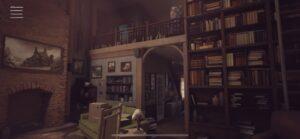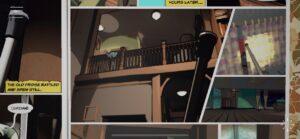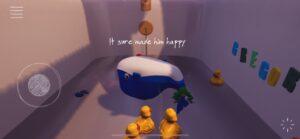NOTE: This entry contains light spoilers for What Remains of Edith Finch.
This week, I sat down to play What Remains of Edith Finch, a narrative-based walking simulator developed by Giant Sparrow and published by Annapurna Interactive. The game is available on Playstation 4/5, Xbox One, Nintendo Switch, and iOS—where I played it. As you walk through the uncanny remnants of the cursed Finch family’s home, a story unfolds before the player of death, misfortune, and familial bonds. The game has something for everyone to appreciate, although its eerie tone and mature themes target an older audience. Living through the deaths of each Finch family member, I found the game addicting, and almost impossible to put down. Ultimately, I argue that What Remains of Edith Finch crafts a uniquely engaging storytelling experience by rewarding exploration with detail and continuously re-inventing gameplay mechanics.
First and foremost, this game is packed to the brim with detail, such that the player is incentivized to take their time and explore the complex environment. Throughout the game, the main vehicles for advancing the story are the text and audio logs that help guide the player through the house and the lives of its past inhabitants. However, the developers supplement this main narrative with painstaking detail in the layout of the house. Subtle additions like posters, news clippings, or just a bit of clutter help color the characters, adding remarkable richness to the game. For example, the walls of the house are lined with books and pictures, all of which contain relevant information about the characters and their lives. By making the text and images on these features legible to the player, the developers incentivize a dynamic of player exploration and deep examination.



Crucially, the designers balance a clear and coherent narrative direction with opportunities to get lost and investigate surroundings. At times, the text pop-ups (somberly narrated by Edith), will dissolve in a certain direction, beckoning the player to follow. Other times, there will be no obvious next step. For instance, I got stuck in Edie’s (Edith’s grandmother) room, unsure of how to proceed. However, instead of feeling frustrated at the lack of objects to interact with in the room, I took the time to really take in the walls and the room of someone who felt as if she were modeled after a real person. From a design perspective, allowing the player the freedom they need to explore is such a powerful mechanic. It gives the more detail-oriented players the time they need to absorb as much as possible, while more impatient players can forge ahead. Furthermore, it increases the odds of replay-ability, as I found myself wishing I could go back and re-explore some of the house as I gleaned more and more about the family’s situation.
In addition to strong attention to detail, What Remains of Edith Finch is an exemplar of how to keep gameplay feeling fresh and . As discussed in the Nicole Clark article (https://www.salon.com/2017/11/11/a-brief-history-of-the-walking-simulator-gamings-most-detested-genre/), one of the chief criticisms of walking simulators is that their gameplay is limited and somewhat monotonous. However, What Remains of Edith Finch sets itself apart from the field by constantly changing up of the modes of storytelling, offering the player a sense of novelty just when the player might grow fatigued of simply navigating the joystick around the house. My favorite demonstration of this comes in Barbara’s storyline, where the game dons a comic book aesthetic, and the player must navigate the house with a crutch as a weapon. At this moment, the player is given the ability to attack objects, making this part of the gameplay feel utterly unique and more akin to a first-person shooter. Another gameplay shift happens during the hunting trip with Dawn and her dad, where the player is now operating a camera and must navigate the story by snapping photos of particular objects in view. Since walking simulators often lack the leveling mechanics which many games rely on to provide constant novelty and depth, the developers of What Remains of Edith Finch are able to ward off player fatigue by keeping the modes of storytelling diverse and ever-changing. Ultimately, this serves the story, and makes each character’s segment feel unique and significant to their personality.



Overall, What Remains of Edith Finch is a masterclass in storytelling. While it could easily captivate as a novel or short film, its game developers take advantage of the unique gifts of the medium to enhance the story. Namely, they reward player exploration with great detail, and keep the mechanisms of storytelling diverse by constantly changing up gameplay. What results is a narrative delight, sure to enthrall anyone who plays.




